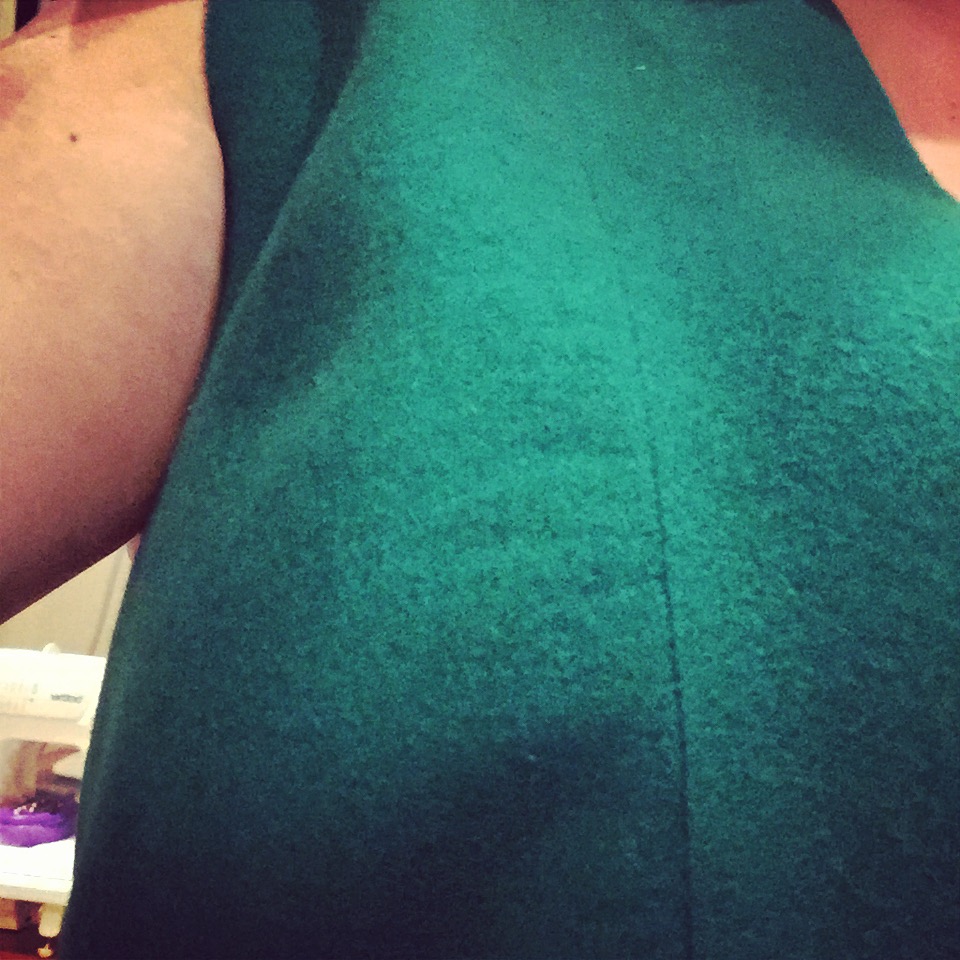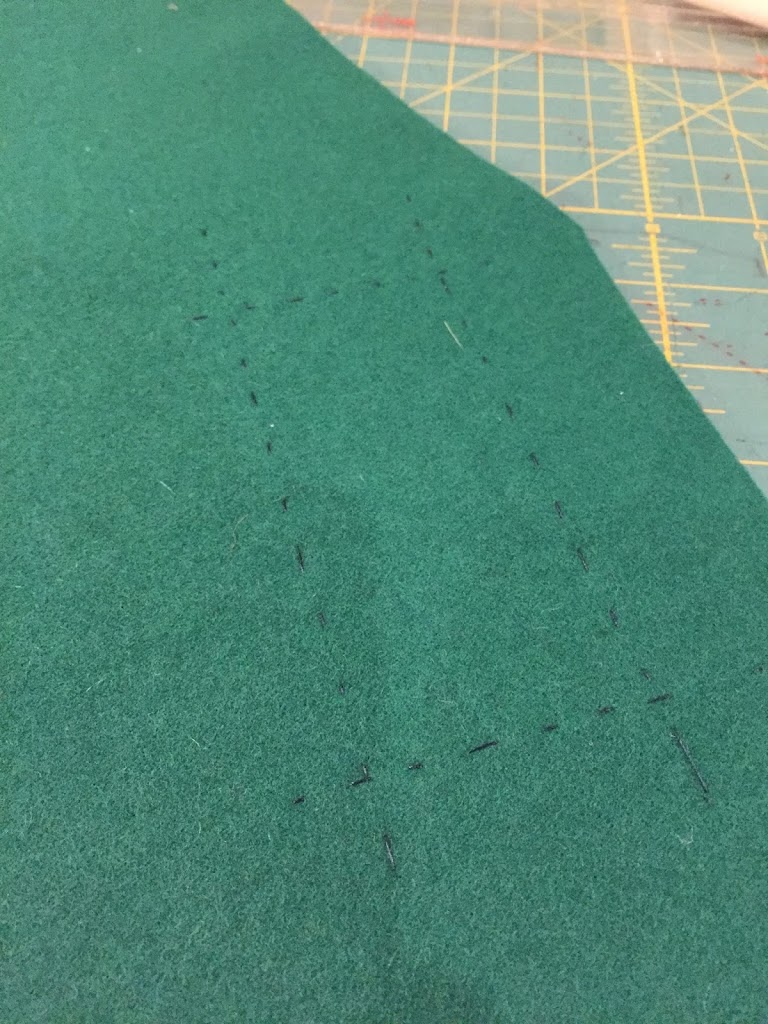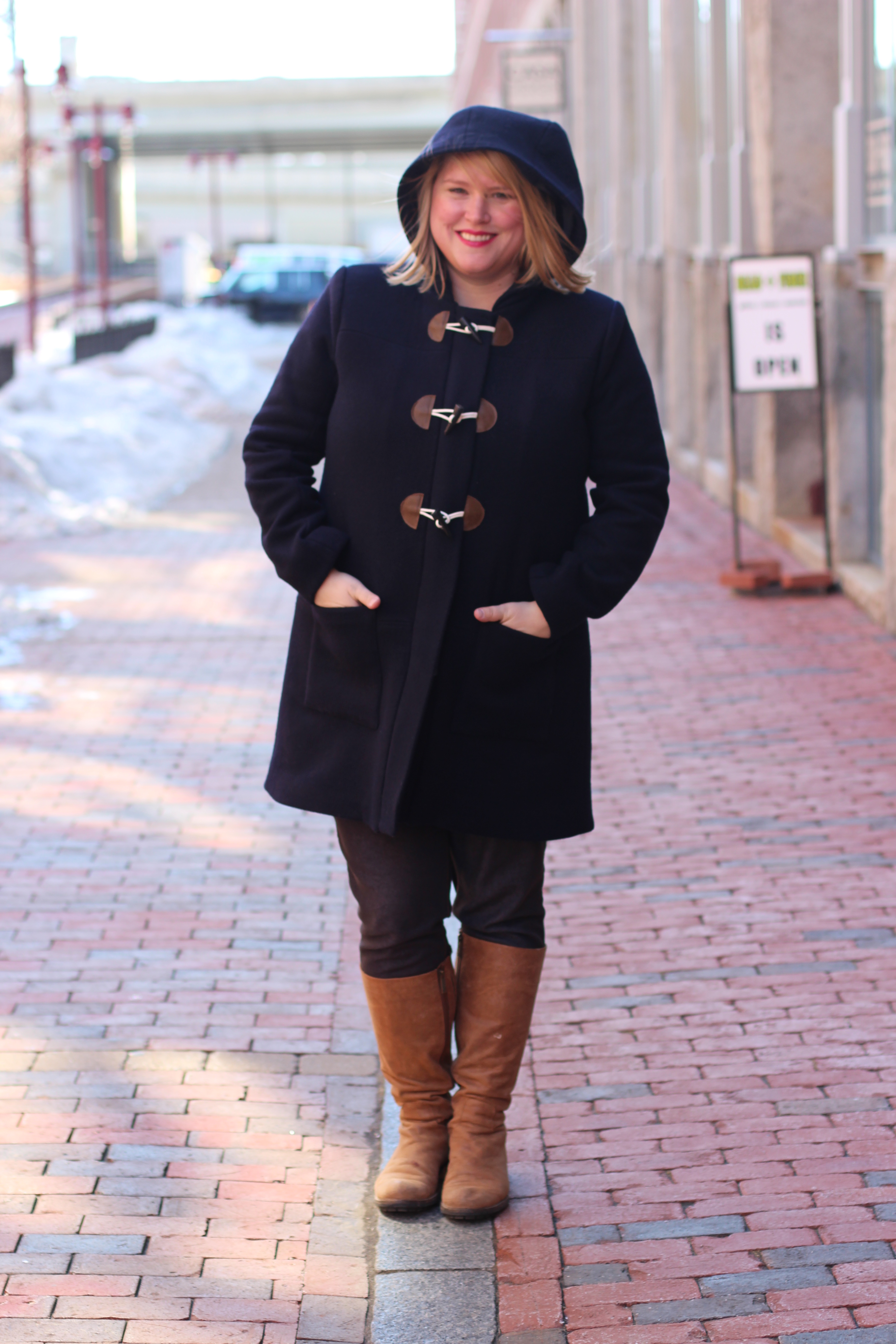Well. I may have made a major mistake with this coat… turns out that fairly thin cashmere with pro-weft interfacing doesn’t like to go around curves. I have many curves. Ipso facto… problem.
I went through the same process I always do with princess seams, going carefully and slowly, doing lots of notching and easing, and then proper pressing etiquette. And then: erk. Firstly, ripples along the princess seam on the side front panel:
I steamed and steamed and steamed this baby, always over a ham, and using my hand to mould it until it cooled. And yet some of these lines just won’t go. I’m not sure whether it’s an issue with the interfacing not being as malleable as the cashmere, or whether the iron is too hot, or the FBA is too big (it wasn’t an issue on my other coat which was made of thicker wool), or what. Realistically it’s unlikely a normal person would notice this, but I AM NOT A NORMAL PERSON in case you’ve ever doubted it. This is seriously bumming me out now, especially as I’m not going to have a giant lapel to cover it up.
Also: how on earth am I going to be able to set in the sleeves nicely if the fabric won’t steam into a curve?!?
Second, it goes concave under my bust, leading to large drag lines from the bust to the side seam (which is just pinned):
Now it’s possible these will go when the sleeve is on and the side seams are sewn. But I’m a bit afraid that they won’t… I tried hand basting hair canvas to the side panel to give it more structure, but it didn’t help. Some theories:1. It’s just a normal thing that happens on princess seam coats to busty ladies and I should get over it
2. I did the FBA wrong.. There does seem to be enough horizontal ease, but it sort of “scoops” under my bust which makes me think maybe the curvy is wrong?
3. It will go away if I put a shoulder pad in or raise the shoulders (I’m going to try that one soon…)
4. There’s something up with the side seam – I’ve already tried playing around with it quite a lot and not found a solution but perhaps I’m missing gsomething
5. I should unpick the whole princess seam (which would be horrendous as it’s already got a trimmed and clipped seam allowance on the other side… WHY DO I ALWAYS DO THIS?!) and try re-pinning until this goes away (if it will/can)
2. I did the FBA wrong.. There does seem to be enough horizontal ease, but it sort of “scoops” under my bust which makes me think maybe the curvy is wrong?
3. It will go away if I put a shoulder pad in or raise the shoulders (I’m going to try that one soon…)
4. There’s something up with the side seam – I’ve already tried playing around with it quite a lot and not found a solution but perhaps I’m missing gsomething
5. I should unpick the whole princess seam (which would be horrendous as it’s already got a trimmed and clipped seam allowance on the other side… WHY DO I ALWAYS DO THIS?!) and try re-pinning until this goes away (if it will/can)
Any advice gratefully appreciated…







First off, this is so not something a lay person would notice. That being said, perfectionism in cashmere coat sewing is so understandable! I would be the same way.
Just from looking at the second picture, I wonder if that scoop isn’t from the bust point of the FBA being a little too high? Though, with clipped curves and seams, I’m not sure what the fix for that would be, honestly. I vote for trying shoulder pads! That would be such an excellent fix. Also, again, I think that’s so not a thing anyone would notice! It’s going to look great, in the end.
Yeah, I’m increasingly coming to the conclusion that people won’t really notice, and perhaps it will even change once the side seams are finished and the sleeves are on. The scoop might be too high – but the shoulder pad would then make it even higher! When I did the FBA last year I was a lot less experienced so I may have just futzed that up and not realised. If this doesn’t work out, I’ll just have to try another 🙂
Did you sew from hem to shoulder, or the other way around? Stitch length? I ask because I get the ripply problems whenever I don’t sew from bottom to top, and use too long a stitch length. But, you’re an infinitely better sewer than I am, and I’m guessing you’ve down all that and more. Hand-shaping? Hand-shaping?! Way to put the rest of us to shame.
However! After the clipping and the trimming and the notching, I wouldn’t unpick. I second Mary (generally, in life), and think the shoulder pads might fix the scoop, too. This is such a tiny thing that a seasoned sewer probably wouldn’t identify on the garment of another unless asked, you know? It’s such a high-impact garment; it’ll stun, even if it’s giving you a headache right now.
Hem to shoulder, both sides, on 2.5 – and to be honest I don’t think it’s the stitching because the back turned out perfectly. It’s the curve that’s proving the problem! *scratches head*
I’m no fit expert and Mary’s right. No one but you will notice/ care!! But if it really bothers you what about putting in a dart there to take the excess fabric out? Have you tried pinning a dart in? I know perhaps you don’t want that but then you have to accept that sometimes we have wrinkles/ lines in our clothes. I wonder if maybe you inadvertently added some fabric there when you did the FBA?
I played around with trying to see what would happen with a dart, but I’m a bit scared of it (because once I do it I can’t go back!). The material is reasonably stiff so when I pin it it looks terrible but maybe if it was sewn it would work… ick!
i’ve had to do what susan khalje calls a “dead dart” when that happened to me, and from the outside you can’t even see where it was, so that might be an option. maybe try one in a scrap piece of fabric to see what it would look like stitched (from the outside) and pressed?
I feel your pain! You can also try loosely hand basting the side seams and hand-basting in the sleeves. I find with jackets that once the sleeves are in the fit looks different to me.
Also, are you in Boston? I’m in the Back Bay. I have a great fitting book recommended by Susan Khalje that shows pictures of every conceivable fit issue and how to fix it. Email me at julieeilber@aol.com if you want to have a look at it.
Ooh which book is that Julie? I have one but I’m not sure if that’s the one you’re referring to…
The book is “Fitting & Pattern Alteration” by Liechty, Pottberg and Rasband. I was looking at it, and it looks like you need more of an FBA for drag lines like that. That’s for fitting a fitting shell, though, not a coat. I’m the first to admit that I’m not an expert, but looking at this book, it may help to give yourself more room on the side seams between the armpit and waist, with more at the pit and tapering toward the waist. But don’t make the armscye any bigger. So you may want to try a loose hand-baste of the side seams, and baste in the sleeves, then put on your clothes under it and walk around and relax in it to see how it fits. And/or you may want to try basting the princess seam inward just under the bust for a few inches, and see if that gets rid of the drag line. Then just unpick that part and take it in. Or baste it all together and then ask a tailor. The guys at Newbury Tailor are really good.
can you let our slightly at the side seam at the end of the wrinkle? from the little bit of the back you can see it looks like it may be pulling slightly? or maybe drooping at the underarm? it’s hard to see if the back is a tight wrinkle or a loose one! as jet set sewing says above, the sleeve might sort it out.
I’ve tried everything from the side seam, from having it super loose to more fitted – but the wrinkle is there *even when the side seam isn’t sewn* ! so it sort of naturally falls like that. It’s definitely not tight – I think if anything it’s too loose.
Oh no! Now I feel bad for saying that I was looking forward to the drama!!! I was thinking drama with a happy solution at the end.
I am sure that you will find a solution. Sending happy sewing vibes your way!
Try stabalizing that seam. Take some scrap, cut two pieces to have the same curve as that seam, interface, sew. Then, sew tape, steam, pray, have a drink, and see . . . Sounds bizarre as hell, but stranger things have worked.
😉
Though, theories 1 and 3 are my contenders.
It’s all stabilized already Annessa – if anything, could be *too* stabilized and making it overly stiff to go around a curve..
Can you peel any of the stabilizer off?
i agree that no one will notice this, but it really looks like the bust fullness is too high. that fabric is just stunning, a slight error like that will be the last thing people are looking at! plus with a scarf and not always having the coat fully buttoned, plus layers underneath… i think you’ll be fine as is. ripping and re-distributing the fullness would probably be possible, though maybe not worth the hassle!
The fabric looks beautiful! I agree with the chorus of people who say it looks pretty darned good, but totally understand your pain that it’s not 100% perfect.
Looks like the FBA threw the curve off. I second basting in the sleeves and seeing if that helps. That would drive me bonkers, too!
Sometimes I think people get “hung up” on over- fitting and end up with a garment that is uncomfortable to wear. You want to be able to layer underneath and not rip out the sleeves while sitting and moving your arms,(as in driving). I would press the princess seam with a business sized envelope between the seam and the coat front and see if those wrinkles disappear. I agree that shoulder pads will help support the weight of the fabric and might help eliminate the wrinkles under the bust; sewing/basting the sleeve will also remove some of that fullness. Tapering the side seam from underarm to waistline would be a last resort. Love the fabric and absolutely the color! Every garment has a hidden story to tell!
i think you needed a forward-shoulder adjustment, which, of course, you can’t do now. but you can try a cheater’s adjustment that frequently works for me. let me first say that if you pull the shoulder seam forward and pull the bust point down and the draglines vanish, then that’s the problem. so here goes:
open the shoulder seam almost to the neckline, but not all the way. lift the front only, a bit at a time and pint it to the back, which you haven’t lifted at all. when you get as good a fit as you can, resew. don’t forget to correct the sleeve. next time, do a forward-shoulder adjustment on the pattern. big busted women frequently need that fix. i hope it works for you. please let me know.
i should have added that you may need to lift as much as 1/2″+, so don’t panic.
I agree with Mary, drag lines always point to where the problem is and in this case you have 2 lines pointing at your bust apex. I have a fairly low bust apex myself (always have to lower side darts by 1.5″), and I get these drag lines when the bust point is too high, so too much fabric above the bust point (fabric pooling between arm and bust point), and not enough below (drag lines as the fabric is forced to stretch to accommodate my bust).
From experience, the only way to fix it is:
1) Wear a bra with more lift, raising your bust apex – this is why I now create garments to be worn with certain bras, as the lift can be as much as 1.5-2cm. And I will wear this same bra during muslin fitting.
2) Unpick the seams and resew. Why don’t you create a piece of test fabric, with the same interfacing, sew the seams, steam, then unpick to see what it does to the fabric? I have a feeling that if you are careful with the unpicking it will be fine, as a good steaming will make what ever holes left by needle and thread disappear.
(Sorry if this post appears twice, not entirely sure what is going on myself)
Hi, first, it’s going to be a beautiful coat. Seems counter-intuitive, but I think you should consider putting an Armani-style chest shield in. It will further stabilize the upper chest, and may in a small way help the concave below the bust drag lines. I agree that it’s a case of the FBA putting the apex too high, and if you’ve clipped your seam there isn’t much to be done now. The other comment I wanted to make is that you can over- steam cashmere. Continuing to steam and fiddle with your seam may only make those tiny dimples worse. Especially true since it’s a light weight cashmere.
Before making any fitting changes I’d baste the whole garment together, including sleeves. It may balance out, and certainly it will fit you well- if not as perfect as you might hope.
Note – the Armani chest shield is in the Threads online index. It’s from a very old issue of the magazine- pre- internet days!